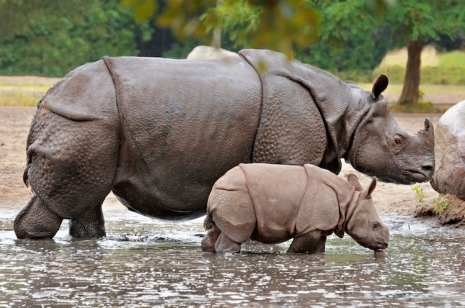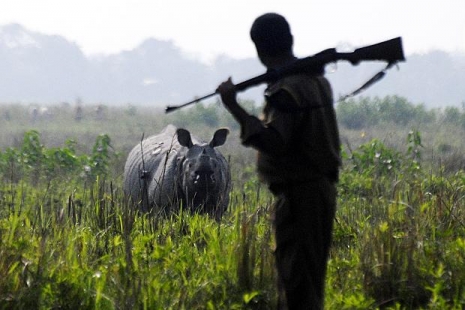
The recovery of the Indian one-horned rhinoceros since its near-extinction in the early 20th century has been a remarkable boon for our planet’s ecosystem—even as it has generated considerable financial opportunities in a part of the world where most of the people have very little. Certain parts of Southeast Asia, particularly Vietnam, has somehow come to believe that the rhino horn has almost magical curative properties, and that has driven the price of the commodity sky-high on the black market—as much as $6,000 for 100 grams. One-horned rhinos have smaller horns than most rhinos, but their horns are especially prized as being extraordinarily potent.
With about 2,400 one-horned rhinos, Kaziranga National Park in the state of Assam in northeastern India is home to a majority of the world’s one-horned rhino population, about two-thirds of the total. The inflated prices for rhino horn have created an incentive for the population of Assam that is all but impossible to ignore. This means that Kaziranga has a serious poaching problem—one that more than doubled in 2013. After several years in which the average number of rhino killings was in single digits, in 2013 and 2014 the number suddenly skyrocketed to more than 25 per year.
As a response to the problem, officials at Kaziranga National Park have adopted an almost unthinkable measure—they permit their park’s security guards to shoot poachers on sight. Such killings of poachers was an uncommon occurrence before 2013—22 documented kills in the eight years before 2014—but it’s spiraled totally out of control, with 22 poachers killed in 2014 and another 23 in 2015. Last year the trend seems to have ebbed, with “only” five poachers meeting their untimely demise at the hands of park security. If you’re keeping track, that’s 72 dead poachers in the span of eleven years.

Everybody thinks that rhinos should be protected from poachers, but this seems seriously out of control.
On top of everything else, not all of the casualties were actually guilty of doing anything wrong.
Justin Rowlatt, South Asia correspondent for the BBC, has done some excellent reporting to shine a light on this shocking situation. He asked Avdesh, a guard at Kaziranga, what he is supposed to do if he spots a poacher off in the distance going after a rhino. “The instruction is whenever you see the poachers or hunters, we should start our guns and hunt them,” he said instantly.
“You shoot them?”
“Yah, yah. Fully ordered to shoot them. Whenever you see the poachers or any people during night-time we are ordered to shoot them.”
Avdesh says that he has never been involved in an incident in which anybody was killed, but he has taken stray shots at poachers twice.
Dr. Satyendra Singh, the director of the park, concedes the basic situation as described above but demurs that the phrase “shoot on sight” is perhaps an exaggeration. Guards are supposed to call out and make inquiries as to who the people are before taking that step. According to Singh, the guards only shoot after they have been fired upon themselves. He says that the goal of any encounter is to achieve an arrest because that is the only way to get further information on the identity of the gangs who undertake poaching.
On one occasion last summer, guards shot a seven-year-old boy named Akash Orang was making his way home along the main track through the village, which borders the park—the blast seriously compromised much of the calf muscle of his right leg.
via Bored Panda
Previously on Dangerous Minds:
Rare Photos Of Now Extinct Beasts





